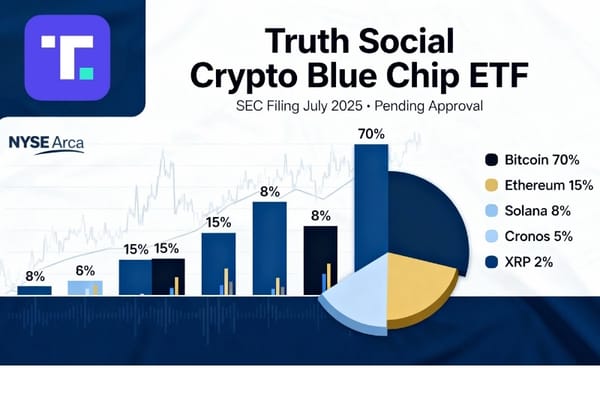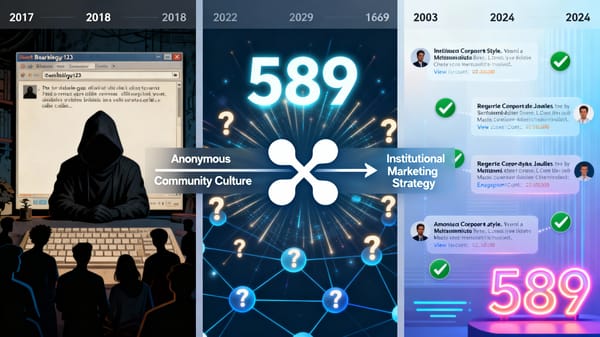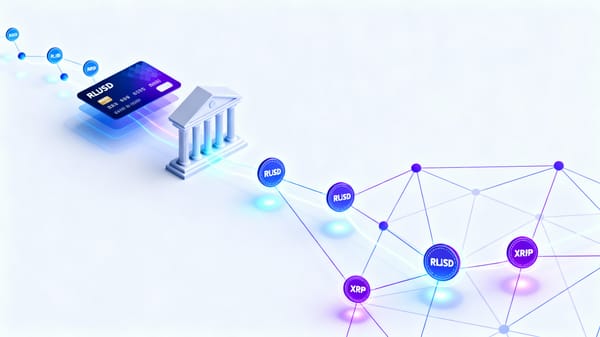Can Crypto Solve America's $1.8 Trillion Student Debt Crisis?
America's $1.8T student debt crisis demands radical solutions. Discover how cryptocurrency and blockchain technology could revolutionize education financing through tokenized income share agreements, DeFi lending, and innovative risk-sharing models.

With student loan debt in the United States totaling $1.814 trillion and 42.5 million borrowers carrying federal loan debt, America faces an unprecedented education funding crisis. The average federal student loan debt has reached a record high of $39,075, while 20% of borrowers are behind on their loan repayments, and the delinquency rate has skyrocketed since pandemic-era relief expired. As traditional solutions fail to address the scale of this crisis, innovative blockchain technologies are emerging as potential game-changers that could revolutionize how we finance education.
The Current Crisis: Beyond Traditional Solutions
The student debt emergency extends far beyond individual hardship. Former White House economic adviser Jared Bernstein recently warned that the U.S. debt outlook now "resembles the student loan crisis", comparing the unsustainable trajectory of national debt to students borrowing beyond their ability to repay. From 1980 to 2017, public university tuition costs increased by 344%, while private college tuition increased by 241%, far outpacing wage growth and creating a perfect storm of unaffordable education.
Traditional federal loan programs, while offering some protections, haven't kept pace with rising costs or provided adequate risk mitigation for borrowers. Income-driven repayment plans help but often extend debt obligations for decades. Private refinancing options exist but typically require excellent credit and eliminate federal protections. The system desperately needs innovation—and cryptocurrency technologies offer compelling alternatives.
Crypto's Current Role in Student Debt Management
Cryptocurrency is already making inroads in student debt management, though primarily through payment processing and alternative lending mechanisms. BitPay Bill Pay provides the flexibility to make monthly student loan payments in crypto directly to lenders using almost any wallet and with more than a dozen top cryptocurrencies, including Bitcoin, Ethereum, Dogecoin, and stablecoins like USDC.
More sophisticated approaches involve DeFi (Decentralized Finance) lending platforms. DeFi loans aren't tied to the traditional banking system, they sometimes have lower interest rates, do not affect the borrower's credit score, and could in theory be held indefinitely. Students with cryptocurrency holdings can use platforms like Aave, Compound, or MakerDAO to borrow stablecoins against their crypto collateral, then convert those funds to pay off traditional student loans.
However, these current solutions come with significant risks. A borrower's collateral can be liquidated if its value drops below the value of the loan, and Bitcoin, despite having more market liquidity than any other cryptocurrency, is still highly volatile, fluctuating in value by an average of 3% per day.
Tokenized Income Share Agreements: The Revolutionary Approach
The most promising crypto-based solution for the student debt crisis lies in tokenizing Income Share Agreements (ISAs). ISAs represent a fundamental shift from debt-based education funding to investment-based models where students pay a percentage of their future income rather than fixed loan amounts.
Using OpenLaw and Ethereum, rights and obligations created through ISAs can be represented as ERC-20 tokens, creating legally enforceable agreements that can be traded on secondary markets. This tokenization model offers several breakthrough advantages:
Risk Alignment: Unlike traditional loans where students bear all the risk of poor job market outcomes, tokenized ISAs align the interests of funders and students. If a graduate earns less, they pay less—providing natural insurance against economic downturns or career setbacks.
Secondary Market Liquidity: Holders of ERC-20 ISA tokens are able to execute OpenLaw contracts to sell their tokens in exchange for Ether, creating liquidity for investors and allowing for more diverse funding sources beyond traditional lenders.
Transparent Market Pricing: Tokenization enables real-time price discovery for different educational programs based on their income outcomes, providing students with better information about return on investment for various degrees and institutions.
Specific Crypto Tools for Student Debt Solutions
1. MakerDAO and Stablecoin Infrastructure
MakerDAO is an Ethereum-based protocol that issues the Dai stablecoin and facilitates collateral-backed loans without an intermediary. A specialized education vault could be created where students deposit crypto assets to mint DAI stablecoins for tuition payments. Unlike traditional DeFi loans, education vaults could offer:
- Extended repayment terms tied to graduation milestones
- Income-based liquidation thresholds that adjust based on post-graduation earnings
- Government backing through federal insurance programs for qualifying students
2. Aave's Advanced Lending Features
Aave supports a wide range of assets and offers fixed-rate loans, variable-rate loans, and flash loans. For student debt applications, Aave's infrastructure could support:
- Flash loans for debt consolidation, allowing students to instantly refinance multiple loans at optimal rates
- aTokens representing student debt positions that could be transferred or used as collateral for other financial products
- Interest rate switching to help students optimize payments based on market conditions
3. Compound's cToken Model for Education
Compound's cToken model has advantages as cTokens can be transferred, traded, and used in other DeFi applications. Education-specific cTokens could represent:
- Institutional lending pool shares where universities deposit endowment funds to earn yield while funding students
- Alumni investment tokens allowing graduates to invest in future students from their alma mater
- Corporate talent pipeline tokens enabling companies to invest in students studying relevant fields
A Comprehensive Web3-Powered Student Financing Ecosystem
Instead of relying on any single blockchain, the most robust solution would leverage the entire Web3 ecosystem, creating a multi-chain education financing platform:
The Universal Education Finance Protocol (UEFP)
A hypothetical comprehensive solution could integrate multiple blockchain technologies:
Core Infrastructure Layer:
- Ethereum: Primary smart contract hub for ISA tokenization and governance
- Polygon: Low-cost Layer 2 for frequent micro-payments and student interactions
- Solana: High-throughput processing for real-time income verification and payment distribution
- Cardano: Energy-efficient platform for developing market applications, already demonstrated through projects like Cardashift
Cross-Chain Connectivity:
- Polkadot/Cosmos: Enable interoperability between different institutional blockchain preferences
- Bridge protocols: Allow students to access funding from any supported blockchain
- Multi-chain payment rails: Including Ripple's XRPL, Stellar, and others for cross-border education financing
Advanced Web3 Features:
- Chainlink oracles: Provide real-time salary data, employment verification, and economic indicators
- Zero-knowledge proofs: Enable income verification while preserving student privacy
- Decentralized identity (ENS, Unstoppable Domains): Portable academic credentials and achievements
- IPFS/Arweave: Decentralized storage for academic records and employment history
- DAOs: Community governance for education funding priorities and risk parameters
Next-Generation Financial Primitives
Automated Market Makers: Uniswap, SushiSwap, and other AMM protocols could create liquid markets for education tokens, enabling price discovery and investor entry/exit.
Yield Optimization: Platforms like Yearn Finance could automatically optimize returns for education funding pools, moving capital to the highest-yielding opportunities across multiple protocols.
DeFi Insurance: Nexus Mutual, Cover Protocol, and other DeFi insurance platforms could protect both students and investors against smart contract failures, economic downturns, or other systemic risks.
NFT Integration: Academic achievements, certifications, and milestone completions could be represented as NFTs, creating additional value streams and verification mechanisms.
Prediction Markets: Platforms like Augur or Polymarket could enable betting on educational outcomes, providing market-driven insights into program effectiveness and job market demand.
The Educated Token (EDUC) Protocol
A hypothetical comprehensive solution could work as follows:
- Student Enrollment: Students apply to the EDUC protocol, providing academic records, intended major, and career goals. Smart contracts assess risk and offer personalized ISA terms.
- Tokenized Funding: Each student's education is funded through ERC-20 tokens representing their future income stream. Tokens are priced based on program quality, job market demand, and historical outcomes.
- Diverse Investor Pool: Tokens can be purchased by:
- Individual investors seeking education-backed returns
- Alumni wanting to support their institutions
- Employers building talent pipelines
- Government entities supporting strategic education priorities
- DeFi yield farmers seeking uncorrelated returns
- Automated Income Collection: Upon graduation, smart contracts interface with payroll systems (with proper privacy protections) to collect percentage-based payments automatically.
- Secondary Market Trading: Investors can trade education tokens on decentralized exchanges, providing liquidity and enabling dynamic pricing based on career developments.
Next-Generation Web3 Financial Primitives
Automated Market Makers (AMMs): Uniswap, SushiSwap, and other AMM protocols could create liquid markets for education tokens, enabling price discovery and investor entry/exit.
Yield Aggregators: Platforms like Yearn Finance could optimize returns for education funding pools, automatically moving capital to the highest-yielding opportunities across multiple protocols.
Insurance Protocols: Nexus Mutual, Cover Protocol, and other DeFi insurance platforms could protect both students and investors against smart contract failures, economic downturns, or other systemic risks.
NFT Integration: Non-fungible tokens could represent unique educational achievements, certifications, or milestone completions, creating additional value streams and verification mechanisms.
Emerging Technologies
Account Abstraction: EIP-4337 and similar technologies could enable students to interact with education financing protocols without needing to understand complex blockchain mechanics.
Decentralized Storage: IPFS, Arweave, and Filecoin could store academic records, employment verification, and other sensitive data in a decentralized, tamper-proof manner.
Prediction Markets: Platforms like Augur or Polymarket could enable betting on educational outcomes, providing market-driven insights into program effectiveness and job market demand.
Social Tokens: Creator economy platforms could enable high-achieving graduates to issue their own tokens, creating new investment and mentorship opportunities.
For Students:
- Reduced financial risk through income-based repayment
- No interest accumulation during unemployment or low-income periods
- Clear payment caps preventing runaway debt growth
- Credit score protection as ISAs don't count as traditional debt
For Investors:
- Diversified exposure to human capital as an asset class
- Potential for higher returns than traditional bonds or savings
- Social impact investing supporting education access
- Hedged risk through portfolio diversification across students and fields
For Educational Institutions:
- Stable funding sources independent of government appropriations
- Market feedback on program value through token pricing
- Alumni engagement through investment opportunities
- Performance incentives as successful graduates increase future funding
For Government and Taxpayers:
- Reduced federal debt burden as private investment replaces government loans
- Market-driven education outcomes improving workforce development
- Maintained access for underprivileged students through targeted subsidies
- Economic data transparency through blockchain transaction records
Real-World Multi-Chain Implementation
Several projects across different blockchains are pioneering aspects of this vision:
Solana Ecosystem: Kamino serves as Solana's largest DeFi lending platform by TVL, demonstrating the blockchain's capacity for high-throughput financial applications. Solana's low fees and fast transaction times make it ideal for frequent micro-payments and real-time income tracking systems.
Ethereum DeFi: Established protocols like Aave, Compound, and MakerDAO provide the foundational infrastructure for decentralized lending, with Aave supporting multiple blockchains and offering advanced features like flash loans.
Cardano Innovation: Cardashift is actively developing tokenized income share agreements for emerging markets, specifically targeting education financing in Africa, demonstrating real-world application of these concepts.
Polygon Scaling: Aave operates as the leading lending protocol on Polygon, providing Layer 2 scaling solutions that dramatically reduce transaction costs for education-related payments and token transfers.
Cross-Chain Opportunities: The Web3 ecosystem's diversity means students could access funding from investors across multiple blockchains, maximizing available capital and reducing dependence on any single network's limitations or regulations.
Challenges and Risk Mitigation
While promising, crypto-based education financing faces significant challenges:
Regulatory Uncertainty: The U.S. Department of Education has proposed new rules to classify ISAs as private education loans, subjecting them to consumer protection laws. Clear regulatory frameworks are needed for tokenized versions.
Technology Risks: Smart contract vulnerabilities, oracle manipulation, and blockchain congestion could disrupt payment systems. Robust auditing and insurance mechanisms are essential.
Market Volatility: Crypto market instability could affect funding availability. Stablecoin-based systems and traditional asset backing can provide stability.
Privacy Concerns: Income tracking for ISA compliance must balance automation with privacy protection. Zero-knowledge proofs and selective disclosure technologies offer solutions.
The Broader Web3 Ecosystem: Multi-Chain Solutions for Education
The student debt crisis solution doesn't require any single blockchain—the entire Web3 ecosystem offers complementary tools for comprehensive education financing:
Layer 1 Solutions
Ethereum: The foundation for most DeFi protocols, offering mature smart contract infrastructure for ISA tokenization, with established protocols like Aave, Compound, and MakerDAO already operational.
Solana: With platforms like Kamino being Solana's largest DeFi lending platform by TVL, Solana's high throughput and low fees make it ideal for frequent micro-payments and real-time income tracking.
Polygon: Aave is considered the best lending protocol on Polygon, offering Layer 2 scaling solutions that dramatically reduce transaction costs for education-related payments and token transfers.
Cardano: Projects like Cardashift are already developing tokenized income share agreements specifically for emerging markets, demonstrating Cardano's capability for social impact applications.
Cross-Chain Infrastructure
Bridge Protocols: Enable students to access funding from multiple blockchain ecosystems, maximizing available capital and reducing dependence on any single network.
Multi-Chain Payment Rails: Technologies like Ripple's XRPL, Stellar, and newer solutions like Chainlink CCIP enable seamless cross-border education payments and multi-currency ISA implementations.
Interoperability Solutions: Cosmos, Polkadot, and other interoperability-focused blockchains could connect education financing across different institutional blockchain preferences.
Specialized Web3 Tools
Decentralized Identity: Platforms like ENS, Unstoppable Domains, and decentralized identity solutions could create portable academic credentials and employment verification systems.
Zero-Knowledge Proofs: Technologies like zk-SNARKs could enable income verification for ISA payments while preserving privacy—critical for widespread adoption.
Oracle Networks: Chainlink and other oracle solutions could provide real-time job market data, salary information, and economic indicators to automatically adjust ISA terms.
Governance DAOs: Educational institutions could implement DAO governance for community-driven decisions about funding priorities, risk parameters, and program development.
The Web3 Advantage: Beyond Traditional Finance
The power of Web3 for education financing extends far beyond simple payment processing:
Programmable Money: Smart contracts can automatically adjust payment terms based on economic conditions, employment status, or other pre-defined criteria without human intervention.
Composability: Education tokens could integrate with other DeFi protocols, allowing students to use their education commitments as collateral for other financial products or enabling complex financial instruments.
Global Access: Unlike traditional banking systems limited by geography and regulation, Web3 protocols can provide education financing to students worldwide, opening opportunities in underserved markets.
Transparency and Auditability: All transactions and contract terms are recorded on public blockchains, providing unprecedented transparency for students, investors, and regulators.
Reduced Intermediary Costs: Eliminating traditional financial intermediaries could significantly reduce the cost of education financing, passing savings directly to students and improving returns for investors.
The student debt crisis requires bold, innovative solutions that align incentives and distribute risk more effectively. Cryptocurrency and blockchain technologies offer unprecedented opportunities to reimagine education financing through:
- Tokenized income share agreements that convert education funding from debt to investment
- DeFi lending protocols providing more flexible and accessible credit options
- Transparent market mechanisms for pricing education value and outcomes
- Global funding pools enabling worldwide investment in human capital
Success will require collaboration between technologists, educators, regulators, and policymakers to create frameworks that protect students while enabling innovation. The $1.8 trillion student debt crisis represents both a tremendous challenge and an equally tremendous opportunity for blockchain technology to demonstrate its potential for positive social impact.
As more institutions experiment with crypto-based financing and regulatory clarity emerges, we may look back on this era as the beginning of a fundamental transformation in how society invests in education—shifting from a debt-driven model that burdens individuals to an investment-driven model that aligns everyone's interests in student success.
DISCLAIMER: This newsletter is for informational purposes only and does not constitute investment advice or a recommendation to buy, sell, or hold any securities. Investments in cryptocurrencies or other financial assets carry significant risks, including the potential for total loss, extreme volatility, and regulatory uncertainty. Past performance is not indicative of future results. Always consult a qualified financial professional and conduct thorough research before making any investment decisions.



